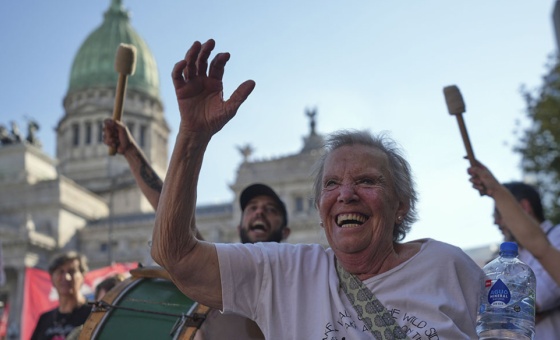This is the last article you can read this month
You can read more article this month
You can read more articles this month
Sorry your limit is up for this month
Reset on:
Please help support the Morning Star by subscribing here
IMAGINE if you can a street-based city 100 miles long, 200 metres wide and four storeys high wrapped around London.
With small-scale factories, schools, houses and shops laid out in terraces along intimately scaled streets and around squares it gives an intense edge to the capital, served by a high-speed orbital monorail. It’s a confident, purposeful boundary fronting a revitalised, productive countryside.
Imagine too a city growing inwards, spreading like wildfire through wasteful, anti-social, car-choked suburbia. Eastwards from Richmond, west across the marshes, up from Eltham, across the hills of Greenwich and the empty green swards and golf courses of Enfield.
This is Metroland consolidated, back-filled, integrated and urbanised and it’s the brainchild of architect Peter Barber who, when I meet him, is more than ready to flesh out that compelling vision on the website of his company Peter Barber Associates (PBA) — and what provoked it.
On the website, Barber rails against “the disgusting donut blocks going up everywhere, the anti-social high-rise shit that people are building and the morons who want London to sprawl into the countryside.
“It is an idea for the house builders and pension funds, the corporations and absentee landlords, lazy architects and weaselly planning consultants who are screwing up this beautiful city from Colindale to Croydon.”
The “plague” of homelessness, with evictions in the private rented sector running at 100 a week in England and Wales and the loss of two million homes to right to buy are, he tells me, figures that infuriate him as somebody professionally involved in housing.
PBA works exclusively in the field of housing and their clients are local authorities, housing trusts and charities. They came to prominence with their work on the now legendary Donnybrook estate in Tower Hamlets, handed over to tenants in January 2006.
What particularly gets Barber’s goat is the simple fact that in the post-WWII period, with the country practically bankrupt, up to 150,000 housing units a year were being built — all of it social but, inexplicably, we are incapable of doing it now. The political will simply isn’t there.
But it was in the very recent past and it’s inevitable that we touch on the inspirational practice of his mentor and friend Neave Brown, this year’s RIBA Gold Medal winner.
Without a doubt the most innovative British housing architect of the 20th century, he was part of the Camden Council architects’ department which, under the inspirational leadership of Sydney Cook, built 38 architecturally ground-breaking estates in a space of barely 20 years. Europe and the world looked on in awe and, to this day, they’re a pilgrimage destination for students of urban development.
Barber identifies with the moral dimension of that heroic vision and recalls his envy at a public meeting where Brown reminisced about centrally planned support, in which the council took the initiative and central taxation was used to finance a tidal wave of exceptional social housing.
A generation later, Barber had to resort to guerilla tactics to outsmart “Thatcherite” legislation designed to curtail any such initiative from ever taking place again.
And he cites the example of Austrian urban planners, who’ve resisted the “neoliberal nonsense” embodied in the ’70s commodification of housing. They stuck to their guns and now 50 per cent of Austrians live in social housing unburdened by colossal mortgages, debt or insecurity.
“As citizens we have every right to demand this from our democratically elected government,” Barber argues. But he recalls the time he met the shadow Labour “person of the moment” in charge of housing to discuss new policy approaches only to hear the jaw-dropping: “We rely on developers.”
The housing crisis needs a three-pronged approach, he stresses. End right-to-buy, which undermines everything, introduce rent controls for the private sector and return to a massive social housing building programme. “This could be started tomorrow and the crisis would end there,” he stresses.
He’s adamant that this strategy is reflected in Labour’s policies, where decommodification of housing and the land economy would dramatically reduce its present speculative investment appeal.
Barber’s vision of the 100-mile city, which he believes could provide 2 million homes in about 15 years, would have a huge impact.
It is a stunning concept, which Barber freely admits is a deliberate provocation designed in part to get us thinking about optimal, not partial, solutions to the housing crisis in this city.
Barber’s not alone in his concern that the gradual outward expansion into the green belt is a social, urban and ecological catastrophe in waiting. He despairs at those clusters of “donut blocks” being planted along the rail approaches to the capital, with little concern for anything other than a quick and exorbitant profit.
Another concern is the ongoing “bulldozing” of well-established inner-city communities and areas of economic productivity that took generations to evolve under the bogus intention of renovation but which are actually crass redevelopments for private profit. He cites Soho, Old Kent Road, Nine Elms and Royal Oak as salient examples.
The images on this page eloquently illustrate how Barber intends to turn the tide. Their genesis was the ideas initially developed with his students at Westminster University, who were assessing the options for an alternative development around Heathrow.
The low density of that suburban environment opened promising vistas and this summer Barber cycled with film-maker Grant Gee (Innocence of Memories) around the capital’s perimeter on a reconnaissance mission, charting the terrain in order to help ideas coalesce around this 100-mile-long built continuum that would offer comfortable living that favours communal cohesion, growth and security.
It’s an admirable vision, unifying simplicity with the panache you’d expect from Barber. He knows that the devil can be in the detail but believes that only central government can initiate an infrastructure project of such magnitude. The good and wellbeing of the majority should take precedence over all else and compulsory purchase of land might be necessary in places —it’s worked for HS2, why not for a 100-mile city?
The build would consist mostly of clusters of four-storey houses — as no lifts are required at that height — along with flats. Barber believes that there is enough private housing about and would rather see the city as made up entirely of social housing, though he’s not adverse to mixed tenancies.
Looking at the models and sketches, the vision comes alive. Brickworks along the way take advantage of clay deposits and, along with the super-fast circular monorail, there’d be local eco transport on the ground and the green belt would be devoted to agricultural production. Its produce would supply the city “across the road” of street-based housing, squares, terraces and balconies — “the innumerable simultaneously animated theatres” so dear to Walter Benjamin.
This is no exercise in wishful thinking. In the heart of Newham, PBA have been testing the 100-mile city concept in reality with the McGrath Road development. Being built as we speak, it includes all the prerequisite components envisaged for the ring city.
Like Cook and Brown before him, Barber is a far-sighted and practical visionary who recognises and articulates collective aspirations of equity and justice shared by many. That’s why the 100-mile city project should be supported as a creative and people-centred solution to the capital’s housing crisis.








